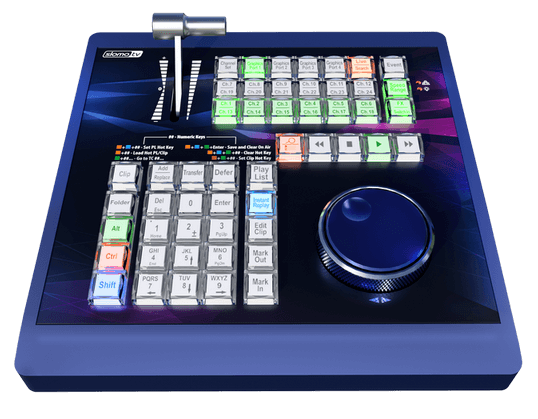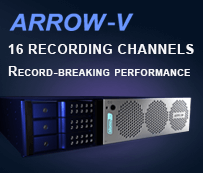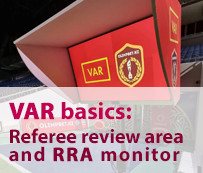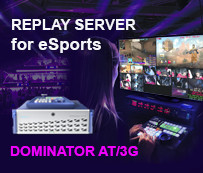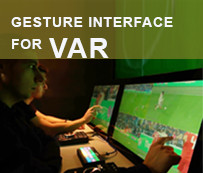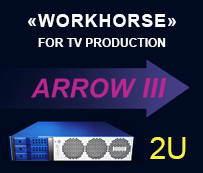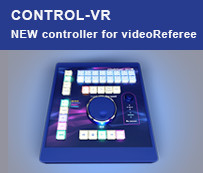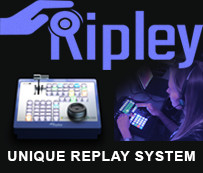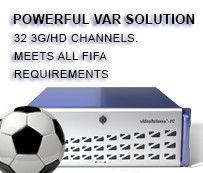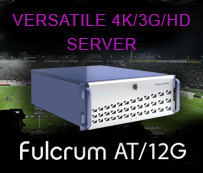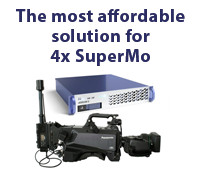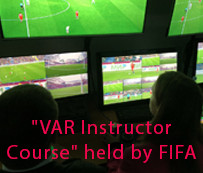What is the "right" interface and what should it be? A good example was the green telephone receiver button on old push-button phones. On the first click it opened the list of recent calls, and with a second click it dialed the last called number. This fast, intuitive and simple operation could be done even with your eyes closed. Modern smartphones certainly have much more functionality, but this has significantly complicated the interface. To speed dial the last number you need to unlock the phone, exit any opened app, go to the "calls" menu, open the tab with recent calls and select a number.
That push-button mobile phone had a simple, fast and intuitive high-performance interface, also due to the fact that it could work "blindly".
Like phones, the functionality of video replay systems over decades has significantly expanded and become more complex. Considering that these systems work in real time, a particularly careful approach to the development of the interface and system controls is required.
Why is the performance and user-friendliness of the interface so important for replay systems, and what benefits does a proper interface bring?
The "right" interface allows the replay operator to easily navigate through the ongoing events and quickly prepare replays, performing more actions in a limited period of time. That in turn leaves more time for orientation in sports situations for creating more pertinent and beautiful replays. The operator better selects the right moments and makes better transitions from one camera to another.
An important feature of the replay systems interface is the absence of needing to constantly switch the focus of attention from one "area of interest" to another. A good example is the Multiviewer built into the main interface of the program, which displays all the channels of the recorded video. The operator does not need to constantly switch attention between the monitor with a Multiviewer and another monitor for clip management and editing.
As mentioned earlier, the "right" interface allows you to perform actions in the simplest and most effective way. For replay systems it is definitely a well-designed replay console. Clearly, the replay system can also be controlled using the keyboard and mouse, however it requires precise positioning of the cursor on strictly defined areas on the screen. The operator constantly needs to switch attention from the "live" signals that he is working with to the cursor position.
In addition, it is possible to press with your finger the desired button from memory, but it is not possible to “blindly” position the mouse on the required control element.
In turn, the "right" replay console does not consume the "visual resource" of an operator. Large tactile buttons are located so that the operator remembers them by touch and does not waste time searching for the right button.
Professional remote control panels have a Jog/Shuttle for quick and accurate positioning of the recorded video. Preparing a replay from multiple cameras using the mouse takes a long time, which is not available when working live. In some competitions interesting moments follow each other, so the interface should provide the fastest possible way for preparation and issuance of replays. This can only be achieved by a specialized remote control with buttons and Jog/Shuttle.
It is for this reason that all professional replay systems have specialized replay consoles.
When designing the remote-control interface for a particular system, you need to have a sufficient number of buttons. The minimalist remote control with a small number of buttons creates the need to implement multiple menus built into the remote control. This distracts the operators from the ongoing action, forces them to switch attention to the menu and consumes precious time. A solution in which 80%-90% of the most frequently used functions can be done "blindly", and the remaining 10%-20% are done through the built-in menu can be a compromise.
In turn, too many buttons cause confusion and require more time to remember and find the right button while working.
Special attention should be paid to the number of buttons for channel selection. Ideally for direct access it must equal the number of channels, or be half that number so any channel can be accessed with only one modifier button.
Replay operators usually work in the dark, so it is helpful to have illuminated buttons with clearly visible symbols.
An important and useful element of the button is its color and light intensity, which show whether the button is currently active or any action is being performed. For example, the "Record" button is usually red. If it is highlighted in bright red, it will tell the operator that recording is active and is underway. The same applies to the channel selection buttons. In the slomo.tv’s replay console Control ZR channels that are available in the system are highlighted in green, and the channel that is currently being used is highlighted in bright green.
The preference should be given to RGB LED buttons, because it opens up more possibilities that can be implemented in the interface. It can draw the operator's attention to certain areas of the remote, to changing function of the button at a given time, and report errors.
However, the interface of replay systems is not only its remote control panel, but also all the tools for the operator's interaction with the system.
Slomo.tv has been engaged in the development and creation of interfaces for replay systems since 2005. Analysis of existing solutions led us to creation of our own original interface, which significantly increases the performance of the replay operator, compared
to working with the classic and common interface architecture. The created interface is based on several innovative principles that allowed us to achieve such results.
First of all, we separated the search and playback channels. Most replay systems still use the same channels for both search and playback. What does it mean? If you have all the channels playing, you cannot search. Conversely, if the system has only 2 playback channels, then the operator can search for two channels at best, but most likely just one.
The separation of channels gave us the opportunity to implement our technology of searching across all channels simultaneously. This allows even an operator who previously worked only on systems with 4 channels, to easily handle the slomo.tv systems with 6-8 channels. Searching synchronously through all channels allows the operator to immediately see which cameras are best for replaying the moment. There is no longer the need to constantly switch channels during searching. This significantly reduces the number of "button presses" and increases the speed of operation, both in the Instant Replay mode and in the Clip Editing mode.
In reality, most replays are prepared by simply rewinding the desired channel, pressing the "Play" button, switching between channels, and after the replay ends, pressing the "Stop" button. Since any broadcasted clip is likely to include a significant game event which may be needed for creating Summary / Highlights, we implemented in our systems automatic saving of all these clips to a dedicated playlist. In other systems, after a live instant replay, the operator must mark up the clip, create it, and manually save it. This takes time and reduces performance, especially if several interesting events occurred sequentially. In our systems the operator has access to all automatically saved clips and can add them to the Summary/Highlights playlist.
We also made it as easy and fast as possible to transfer clips from Instant Replay to Edit Mode. Special buttons allow you to add a clip or playlist that you just created in Instant Replay mode to the playlist that is currently being edited. In the same way, the clip created in Edit mode is immediately added to the playlist that the operator is currently working with. This again reduces the number of necessary actions - 4 clicks (Mark In, Mark Out, Create, Add) versus 3 in slomo.tv servers (Mark In, Mark Out, Create).
Later, we implemented another time-saving mechanism. We have made it possible to edit two playlists simultaneously and in parallel, for example, the general Summary/Highlights and all the moments in which a particular player is involved. Any clip created in Instant replay mode or marked up in Edit mode can be added to one or both playlists at once.
The applied principles allowed to increase the productivity of operators working on slomo.tv servers 2-4 times compared to other servers.
What are the benefits for users of such system?
For starters, the fast and optimized interface allows you to reduce the number of replay operators of a broadcast without affecting quality. Using a slomo.tv server an operator, even without extensive experience, could work with 8 cameras (channels) performing instant replays, creating various playlists and Summary/Highlights.
You will be able to:
- Save on salaries, and travel expenses;
- Reduce the number of personnel in OB Vans (1-2 operators replace 2-4);
- Reduce the time and cost of staff training.
Also, all the technologies implemented in our servers have led to the appearance of first-class replay operators who can, working on slomo.tv servers, single-handedly handle 12-15 channels in eSports competitions. When one operator works with such a large number of channels, then no additional resources are required to coordinate actions between operators. One operator can independently (without the help of the replay director) choose and produce the needed replay.
To sum up, a highly efficient interface that combines on the monitor screen a Multiviewer, clip editing and playback control tools, together with a specialized remote control optimized for "blind" operation with a large number of functions, and a special server architecture allows you to produce high-quality spectacular broadcasts with significant savings in financial and human resources.



